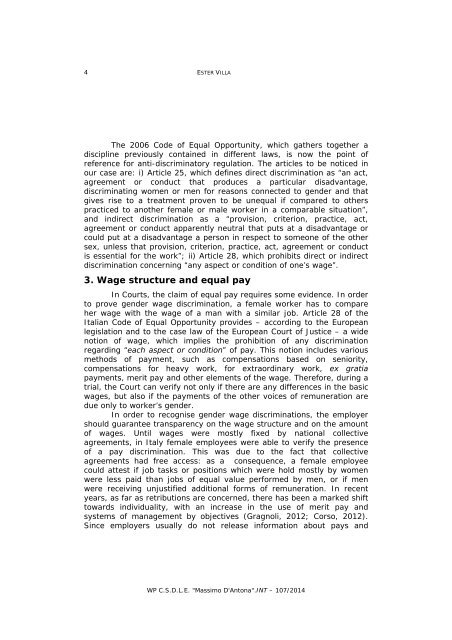o37gja3
o37gja3
o37gja3
Create successful ePaper yourself
Turn your PDF publications into a flip-book with our unique Google optimized e-Paper software.
4 ESTER VILLAThe 2006 Code of Equal Opportunity, which gathers together adiscipline previously contained in different laws, is now the point ofreference for anti-discriminatory regulation. The articles to be noticed inour case are: i) Article 25, which defines direct discrimination as “an act,agreement or conduct that produces a particular disadvantage,discriminating women or men for reasons connected to gender and thatgives rise to a treatment proven to be unequal if compared to otherspracticed to another female or male worker in a comparable situation”,and indirect discrimination as a “provision, criterion, practice, act,agreement or conduct apparently neutral that puts at a disadvantage orcould put at a disadvantage a person in respect to someone of the othersex, unless that provision, criterion, practice, act, agreement or conductis essential for the work”; ii) Article 28, which prohibits direct or indirectdiscrimination concerning “any aspect or condition of one’s wage”.3. Wage structure and equal payIn Courts, the claim of equal pay requires some evidence. In orderto prove gender wage discrimination, a female worker has to compareher wage with the wage of a man with a similar job. Article 28 of theItalian Code of Equal Opportunity provides – according to the Europeanlegislation and to the case law of the European Court of Justice – a widenotion of wage, which implies the prohibition of any discriminationregarding “each aspect or condition” of pay. This notion includes variousmethods of payment, such as compensations based on seniority,compensations for heavy work, for extraordinary work, ex gratiapayments, merit pay and other elements of the wage. Therefore, during atrial, the Court can verify not only if there are any differences in the basicwages, but also if the payments of the other voices of remuneration aredue only to worker’s gender.In order to recognise gender wage discriminations, the employershould guarantee transparency on the wage structure and on the amountof wages. Until wages were mostly fixed by national collectiveagreements, in Italy female employees were able to verify the presenceof a pay discrimination. This was due to the fact that collectiveagreements had free access: as a consequence, a female employeecould attest if job tasks or positions which were hold mostly by womenwere less paid than jobs of equal value performed by men, or if menwere receiving unjustified additional forms of remuneration. In recentyears, as far as retributions are concerned, there has been a marked shifttowards individuality, with an increase in the use of merit pay andsystems of management by objectives (Gragnoli, 2012; Corso, 2012).Since employers usually do not release information about pays andWP C.S.D.L.E. "Massimo D'Antona".INT – 107/2014


